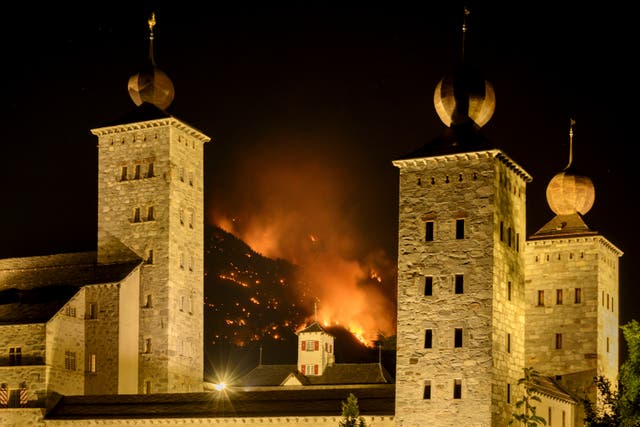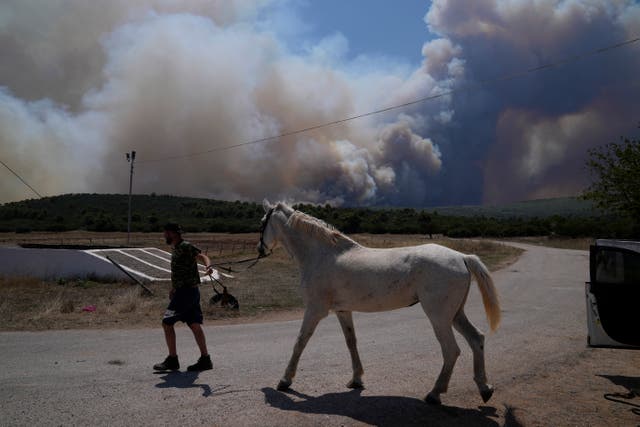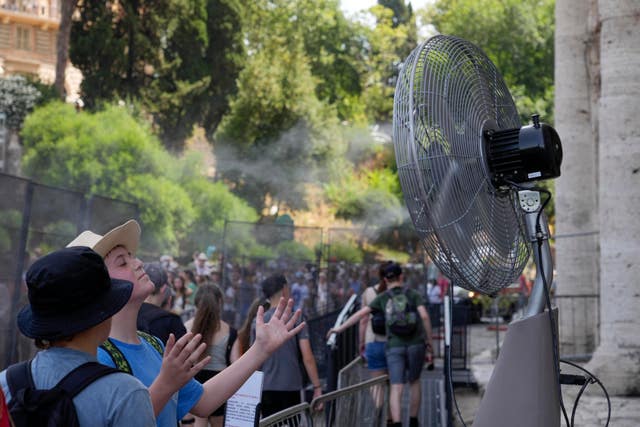
Residents and tourists at Mediterranean destinations have been told to stay indoors as a second heatwave in as many weeks hits the region – and as Greece, Spain and Switzerland battle wildfires.
In Italy, Red Cross teams checked on the elderly by phone while in Portugal they took to social media to tell people not to leave pets or children in parked cars.
In Greece, volunteers handed out drinking water, while in Spain they reminded people to protect themselves from breathing in smoke from fires.
Several countries in southern Europe are sweating through a new heatwave, amplified by climate change, which is expected to persist for days.

The UN weather agency said temperatures in Europe could even break the 48.8C record set in Sicily two years ago as concerns grow that the heat will provoke a spike in deaths.
“Heatwaves are really an invisible killer,” Panu Saaristo, emergency health unit team leader for the International Federation of Red Cross and Red Crescent Societies, told a briefing in Geneva.
“We are experiencing hotter and hotter temperatures for longer stretches of time every single summer here in Europe.”
Heat records are being shattered all over the world and scientists say there is a good chance that 2023 will go down as the hottest year on record, with measurements going back to the middle of the 19th century.
June saw the warmest global average temperature, according to Europe’s Copernicus Climate Change Service, and the UN’s World Meteorological Organisation (WMO) predicted that a number of heat records are set to fall this summer.
The WMO said unprecedented sea surface temperatures and low Arctic sea-ice levels are largely to blame.
Human-caused climate change from the burning of coal, oil and natural gas is making the world hotter and is being amplified by the naturally occurring El Nino weather phenomenon.

But the current El Nino only started a few months ago, is still weak to moderate and is not expected to peak until winter.
Temperatures above 40C are forecast to persist not only in the Mediterranean, but across North America, Asia and North Africa.
In Italy, health officials warned of extreme temperatures in 20 cities, rising to 23 on Wednesday, from Bolzano in the north to Palermo in the south.
In Greece, where a second heatwave is expected to hit on Thursday, three large wildfires burned outside Athens for a second day.
Thousands of people evacuated from coastal areas south of the capital returned to their homes on Tuesday when a fire finally receded after they spent the night on beaches, hotels and public facilities.
But wildfires continued to burn out of control to the north and west of Athens.
Authorities last week introduced changes in working hours and ordered afternoon closures of the Acropolis and other ancient sites to allow workers to cope with the high heat.
Temperatures as high as 44C are expected in parts of central and southern Greece by the end of the week.

Most of Spain is under alert for high to extreme heat, with forecasts calling for peak temperatures of 43C in areas along the Ebro River in the northeast and on the island of Mallorca.
Spain is also dealing with a prolonged drought that has increased concerns about the risk of wildfires.
Some 400 firefighters assisted by nine water-dumping aircraft laboured to extinguish a wildfire which burned for a fourth consecutive day on La Palma in Spain’s Canary Islands.
Authorities said a perimeter has been established around the blaze but it is still active.
In Switzerland, some 150 firefighters, police, troops and other emergency teams backed by helicopters fanned out on Tuesday to fight a wildfire that engulfed a mountainside in the southwestern Wallis region, evacuating residents of four villages and hamlets in the area.
In a report on Monday, the WMO said a committee of experts has verified the accuracy of the 48.8C record set on August 11 2021 in Sicily.
A full report has not yet been published.
The previous verified record of 48C was set in Athens on July 10 1977.
“These are not your normal weather systems of the past. They have arrived as a consequence of climate change,” said John Nairn, senior extreme heat adviser for the WMO.
“It is global warming and it’s going to continue for some time.”
Nairn noted a sixfold increase in simultaneous heatwaves since the 1980s – “and the trend line isn’t changing”.


Comments: Our rules
We want our comments to be a lively and valuable part of our community - a place where readers can debate and engage with the most important local issues. The ability to comment on our stories is a privilege, not a right, however, and that privilege may be withdrawn if it is abused or misused.
Please report any comments that break our rules.
Read the rules here